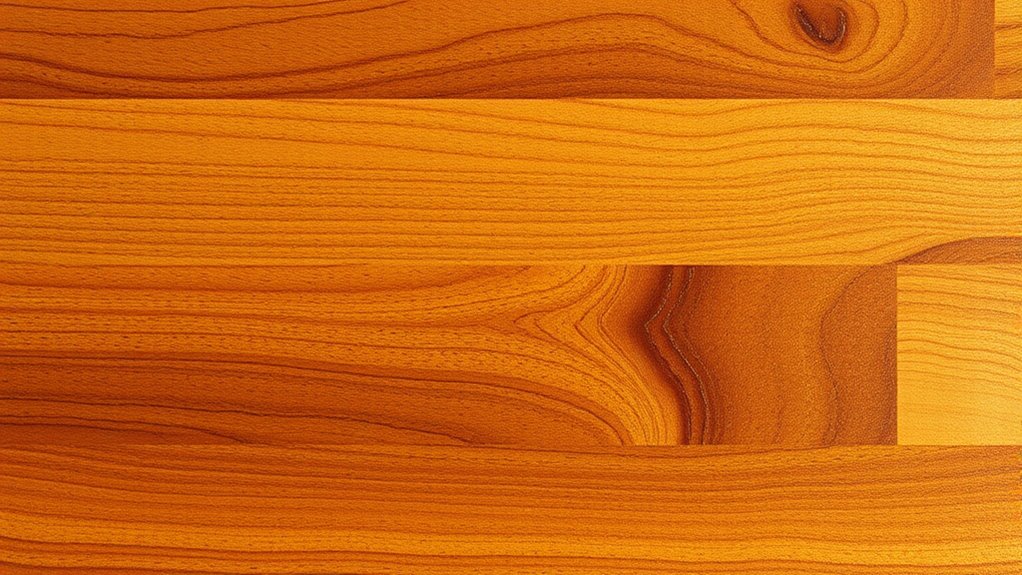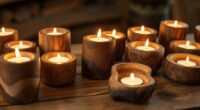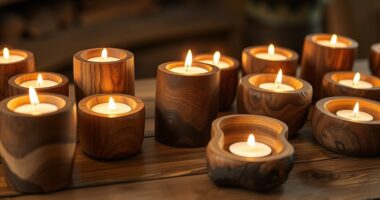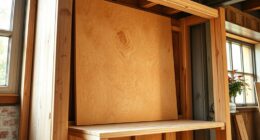If you want stunning finishes, I recommend exploring a mix of classic and innovative veneering techniques like bookmatching, marquetry, and curved panels, using tools such as vacuum presses and clamps. I also suggest trying quality products like dyed maple sheets, natural burl veneers, and exotic wood packs. Mastering proper gluing, pressing, and handling thin veneers is essential. Keep going, and I’ll guide you through the top methods and products to elevate your craftsmanship.
Key Takeaways
- Master traditional techniques like bookmatching, marquetry, and curved panels for intricate, eye-catching veneer designs.
- Utilize high-quality veneer products such as dyed maple sheets, burl veneers, and wood samples for diverse finishes.
- Employ advanced tools like vacuum bagging, clamps, and router inlays to achieve flawless, professional veneer applications.
- Incorporate decorative techniques like spiral matching, parquetry, and textured grains to create stunning visual effects.
- Follow comprehensive guides and tutorials to learn proper gluing, pressing, and finishing methods for durable, high-end results.
The Craft of Veneering

If you’re looking for an all-encompassing resource on veneering that suits everyone from beginners to advanced woodworkers, “The Craft of Veneering” is the best choice. I found it incredibly thorough, covering everything from basic panel projects to complex techniques like bookmatching and curved panels. The author, Craig Thibodeau, explains concepts clearly with step-by-step guidance and abundant color photos. It’s perfect for those new to veneering and seasoned artisans alike. I appreciate how it emphasizes essential tools like vacuum bagging and clamps, making complex processes accessible. This book has become my go-to reference, helping me confidently explore artistic techniques like marquetry and parquetry.
Best For: beginners to advanced woodworkers seeking a comprehensive, clear, and practical guide to veneering techniques and projects.
Pros:
- Well-illustrated with abundant color photographs and step-by-step instructions.
- Covers a wide range of topics from basic to advanced veneering methods, including artistic techniques.
- Author Craig Thibodeau is highly knowledgeable, making complex concepts accessible and practical.
Cons:
- Some readers might find the level of detail overwhelming for complete beginners.
- The physical book is often recommended to be spiral-bound for shop use, which may require additional purchase or modification.
- As a highly detailed manual, it may be less suitable for those seeking quick, simplified guidance.
Veneering Essentials: Techniques & Projects for Woodworkers
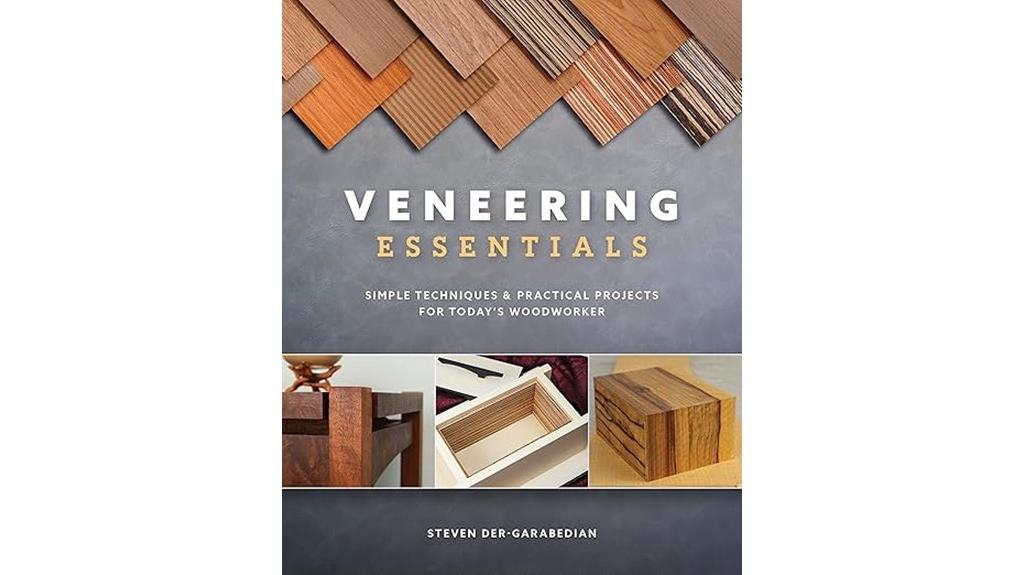
Veneering Essentials is an ideal resource for woodworkers who want to master the art of veneering without feeling overwhelmed by complexity. As a professional woodworker and instructor, Steve Der-Garabedian provides clear, step-by-step guidance, making veneering accessible for beginners and rewarding for seasoned craftsmen. The book emphasizes simple techniques, detailed instructions, and visual aids that demystify the process. It also showcases practical projects, proving that veneering can be creative, straightforward, and highly effective. By challenging misconceptions, it encourages woodworkers to see veneering as a valuable skill that elevates their craftsmanship and design possibilities.
Best For: beginner and experienced woodworkers seeking a clear, practical guide to veneering techniques and projects.
Pros:
- Provides step-by-step instructions with detailed visual aids for easy understanding.
- Offers practical projects that demonstrate the versatility and creativity of veneering.
- Challenges common misconceptions, inspiring confidence and appreciation for veneering.
Cons:
- Focuses primarily on basic techniques; advanced veneering methods may require additional resources.
- May be less suitable for those looking for highly technical or specialized veneering processes.
- As a printed book, it may require physical handling, which could be less convenient for quick reference during work.
Woodworkers Guide to Veneering & Inlay
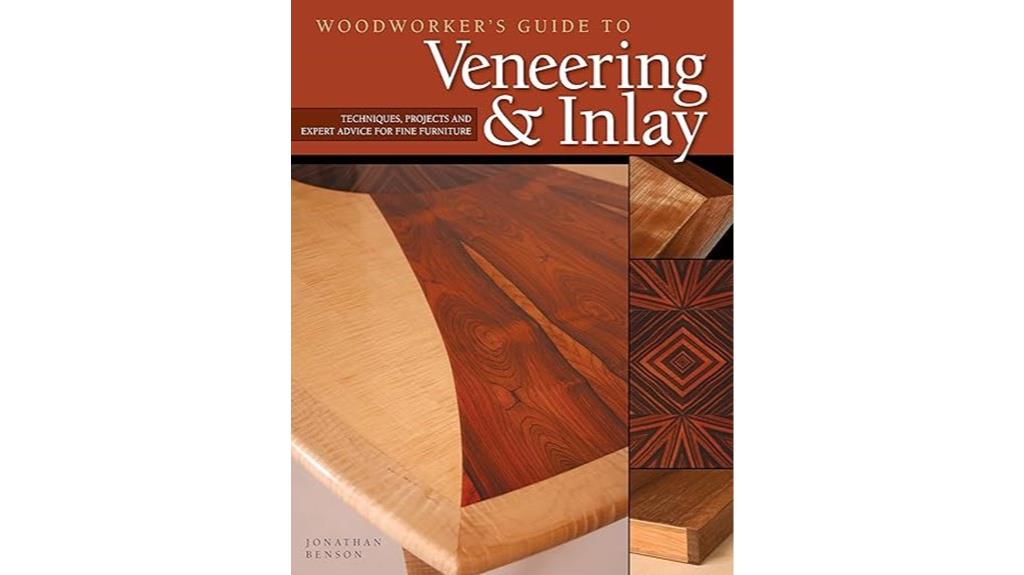
Woodworkers Guide to Veneering & Inlay is an excellent resource for both beginners and experienced craftspeople looking to expand their skills in decorative woodworking. It covers the fundamentals of veneer and inlay techniques, highlighting their role in creating stunning surfaces, restoring antiques, and adding intricate designs. The guide explains essential materials, tools, and methods, such as gluing, pressing, and pattern matching, making complex projects accessible to all skill levels. With detailed instructions, project ideas, and troubleshooting tips, this resource helps you build confidence and master the art of veneering and inlay, elevating your woodworking craftsmanship.
Best For: both beginner and experienced woodworkers seeking comprehensive guidance to enhance their veneering and inlay skills for decorative projects and furniture restoration.
Pros:
- Provides detailed step-by-step instructions and project ideas suitable for all skill levels
- Covers a wide range of techniques, tools, and materials to build confidence and mastery
- Includes troubleshooting tips and repair advice for common veneering issues
Cons:
- May require additional resources or videos for visual learners seeking more visual guidance
- Some projects might necessitate specialized tools or equipment not included in basic woodworking setups
- The depth of information might be overwhelming for absolute beginners without prior woodworking experience
10 Colors Maple Wood Veneer Sheets, Craft DIY Guitar Marquetry Woodworking
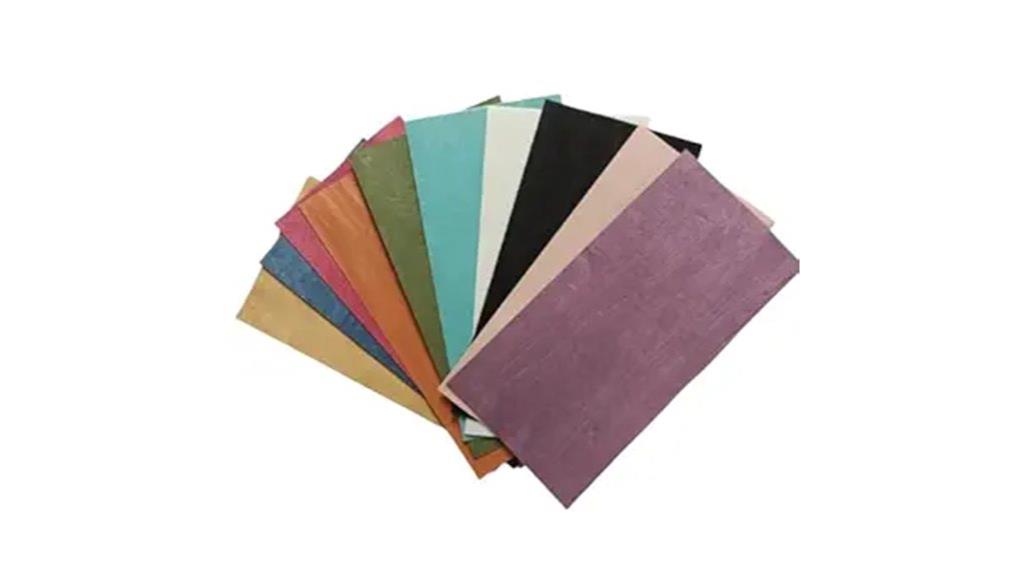
Looking to add vibrant, eye-catching accents to your woodworking projects? These 10 Colors Maple Wood Veneer Sheets are perfect for DIY guitar marquetry, inlays, and decorative accents. Each sheet measures 7.8×4 inches, crafted from high-quality dyed maple with a mountain grain pattern, ensuring durability. The thin 0.4mm thickness makes them flexible and easy to work with. The assortment includes bold colors like black, red, green, and purple, giving you plenty of options for creative expression. Whether refurbishing a guitar, decorating furniture, or creating art, these veneers offer versatile, stunning finishes that elevate your craftsmanship.
Best For: DIY enthusiasts, woodworkers, and artisans seeking vibrant, versatile veneer sheets for detailed craft projects, guitar inlays, and decorative woodworking.
Pros:
- High-quality dyed maple veneer with durable mountain grain pattern
- Thin 0.4mm thickness provides excellent flexibility for detailed work
- Wide range of bold colors suitable for various creative applications
Cons:
- Small sheet size (7.8×4 inches) may require multiple pieces for larger projects
- Without paper backing, handling and adhesion may require careful application techniques
- Limited to specific thin veneer projects; not suitable for structural purposes
Advanced Veneering and Alternative Techniques
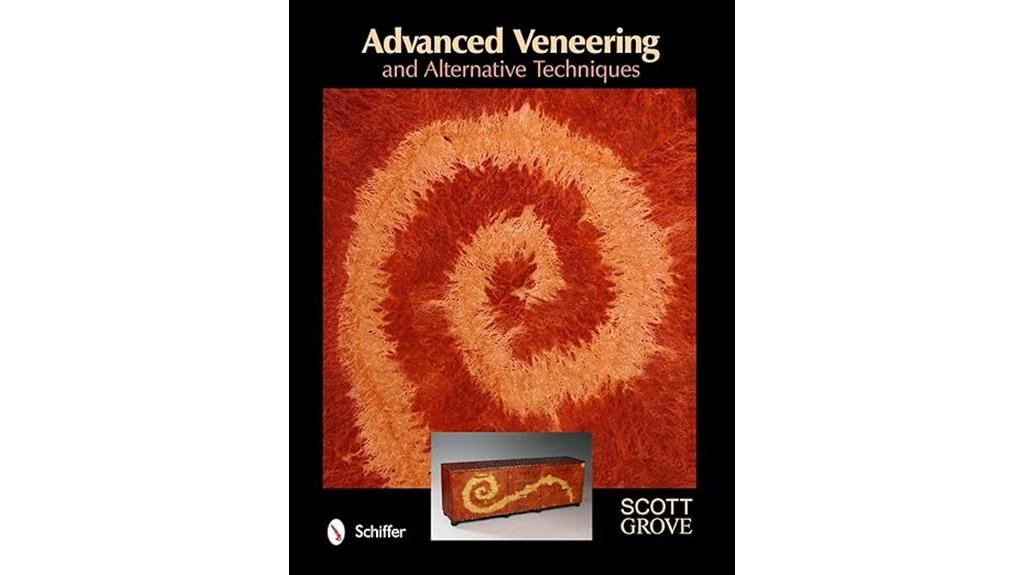
If you’re enthusiastic to push your veneering skills beyond the basics, “Advanced Veneering and Alternative Techniques” offers invaluable insights for both seasoned craftsmen and dedicated beginners. Scott Grove’s guide covers a wide array of methods, from traditional techniques to innovative methods like wavy contour seams and spiral matching. It provides detailed step-by-step instructions, practical tips, and artistic ideas for working with burls, textured grains, and color variations. The book emphasizes understanding veneer properties, using alternative techniques like router inlay, and exploring creative possibilities. It’s a thorough resource that can elevate your craftsmanship and inspire you to experiment with complex, stunning veneering projects.
Best For: woodworkers of all skill levels seeking to deepen their veneering expertise through detailed techniques, creative ideas, and practical guidance.
Pros:
- Comprehensive coverage of both traditional and innovative veneering methods with clear, step-by-step instructions.
- Rich with artistic insights, visual examples, and tips that inspire experimentation and enhance craftsmanship.
- Suitable for beginners and experienced woodworkers looking to refine or expand their veneering skills.
Cons:
- Might be overwhelming for absolute beginners due to the depth of advanced techniques covered.
- Requires access to specific tools and materials for some of the more complex methods.
- As a printed resource, it may lack the interactive, visual demonstration that video tutorials provide.
40-6 x 12 Labeled Wood Veneer Pieces (20 Sq Ft)
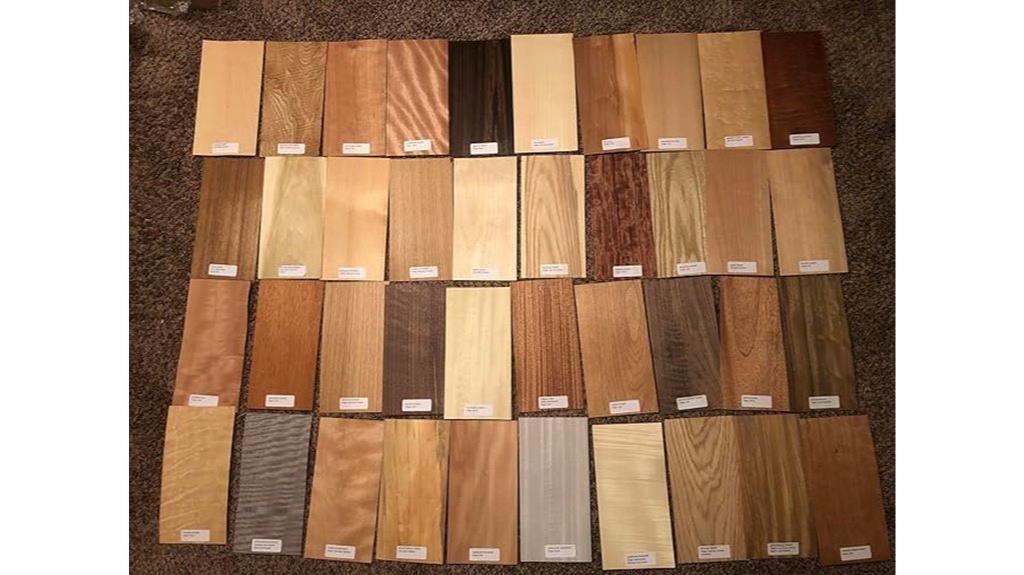
For those seeking a versatile and high-quality veneer assortment, the 6 x 12 labeled wood veneer pieces offer a perfect solution. This set includes 40 pieces measuring 6″ x 12″, totaling 20 square feet, with industry-standard thickness of 1/42 inches. Each piece is pure wood, without adhesives or backing, and is clearly labeled with veneer type and country of origin, making selection easy. The collection features exotic and domestic species with varied grains and colors, suitable for marquetry, parquetry, and decorative crafts. All pieces are flat, with minimal warping and blemishes, ensuring consistent quality for your projects.
Best For: hobbyists, woodworkers, and craft enthusiasts seeking a high-quality, versatile veneer assortment for detailed projects and decorative woodworking.
Pros:
- Includes a variety of exotic and domestic species with diverse grains and colors, perfect for creative projects.
- Labeled with veneer type and country of origin, making species identification quick and easy.
- Thin, flat pieces (1/42 inches) with minimal warping, suitable for seamless veneering applications.
Cons:
- Some customers have received duplicate species instead of all unique pieces, which may limit variety.
- The set is primarily intended for small projects, so larger-scale applications may require additional veneer sheets.
- Limited to 40 pieces, which might not be enough for extensive or multiple projects at once.
Wood Identification Kit
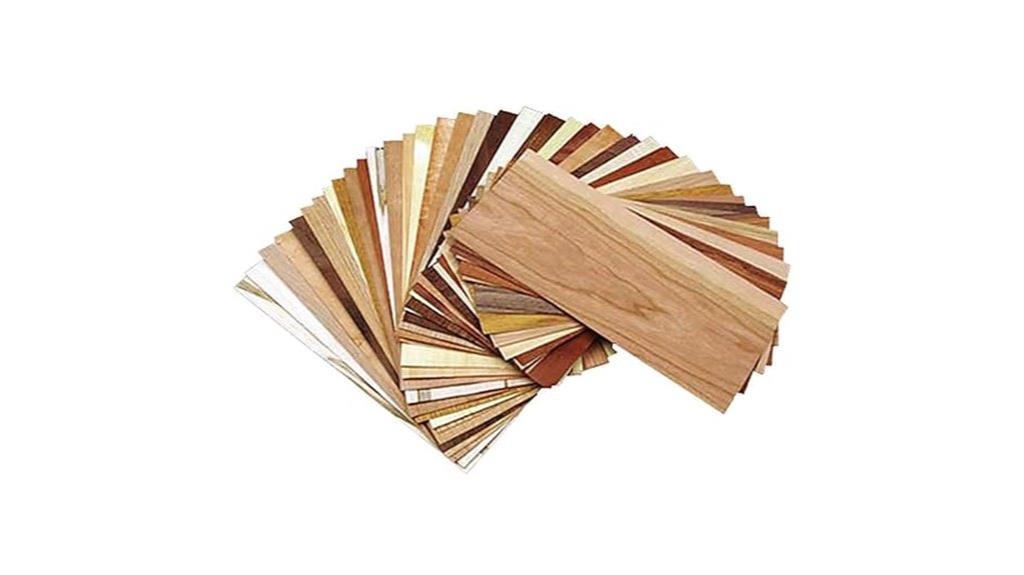
A Wood Identification Kit is an essential tool for woodworkers, crafters, and miniature makers enthusiastic to distinguish between various wood types through tactile and visual examination. It includes 50 high-quality samples, both veneer and solid wood, measuring 4 x 9 inches. The set offers a broad selection of domestic and exotic woods, showcasing different grain patterns, colors, and textures. Some pieces are warped or brittle, requiring careful handling, but overall, it provides an excellent hands-on experience. This kit helps users identify woods for projects, understand grain characteristics, and explore exotic options, making it a valuable resource for enhancing woodworking and veneering techniques.
Best For: hobbyist woodworkers, crafters, and miniature makers seeking a tactile and visual way to identify and explore a wide variety of wood types, including exotic and veneer options.
Pros:
- Offers a diverse selection of 50 high-quality wood samples, including both veneer and solid woods
- Facilitates hands-on learning and identification of grain patterns, colors, and textures
- Suitable for a range of projects from miniatures to crafts, enhancing understanding and inspiration
Cons:
- Samples are very dry, thin, and sometimes warped or brittle, requiring careful handling
- Short sample lengths may limit use in certain projects like rings or detailed designs
- Lacks an included storage solution, which could lead to difficulty organizing and protecting samples
Natural Black Walnut Burl Wood Veneer (0.25mm, 98×20.8in)
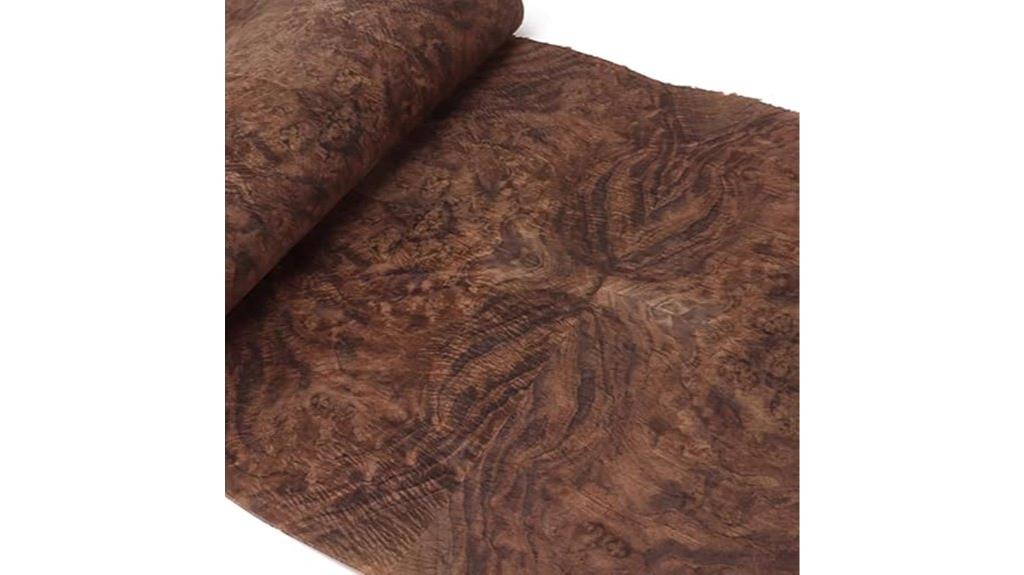
Natural Black Walnut Burl Wood Veneer (0.25mm, 98×20.8in) offers a stunning, natural pattern that makes it ideal for DIY enthusiasts and professional woodworkers seeking unique, high-quality finishes. Its thin, hand-applied layer showcases the rich colors and intricate textures of walnut burl, perfect for accents on furniture, musical instruments, or wall decor. The veneer’s kraft paper backing provides stability and ease of handling, ensuring smooth application. Because each piece is naturally varied, you’ll get one-of-a-kind results. I recommend using contact cement and proper surface prep to achieve flawless, professional-looking finishes that highlight the distinctive beauty of this walnut burl veneer.
Best For: DIY enthusiasts, professional woodworkers, and artisans seeking high-quality, natural burl veneer for furniture, musical instruments, and decorative projects.
Pros:
- Unique, natural patterns and textures due to individual burl variations.
- Thin, lightweight veneer that is easy to apply and handle.
- Backed with kraft paper for added stability and stress resistance during installation.
Cons:
- Variability between batches can affect color and texture consistency.
- Requires proper surface preparation and adhesives for optimal results.
- Shipping width limitations may restrict larger projects in certain regions.
Fine Woodworking on Marquetry and Veneer
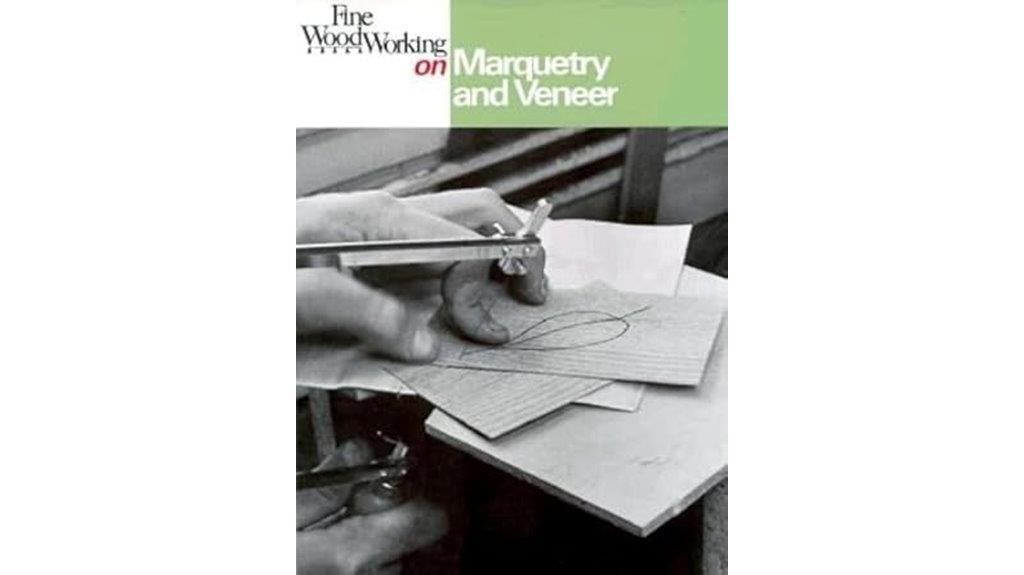
Are you passionate about traditional craftsmanship and enthusiastic to master the art of decorative woodworking? I’ve found that fine woodworking on marquetry and veneer combines artistry with precision. Resources like Fine Woodworking magazine have been invaluable, providing detailed articles on techniques, design, and craftsmanship since 1975. They cover everything from slicing rare woods into thin leaves to creating intricate pictures with colorful veneers. While some older methods are still relevant, modern advancements like vacuum presses are often missing. Still, these guides teach fundamental skills—sawing, laying, and assembling—that are essential for both hobbyists and pros aiming for stunning, detailed finishes.
Best For: hobbyists and professionals seeking foundational techniques and inspiration in traditional marquetry and veneering craftsmanship.
Pros:
- Comprehensive coverage of fundamental sawing, laying, and assembling techniques.
- Rich visual illustrations and step-by-step guides suitable for all experience levels.
- Emphasis on traditional craftsmanship and use of beautiful, rare woods.
Cons:
- Some content is outdated, lacking modern advancements like vacuum presses.
- Limited information on current tools, sourcing, and contemporary techniques.
- May require supplementing with newer publications for up-to-date methods and technology.
Tage Frid Teaches Woodworking, Book 2: Shaping, Veneering, Finishing
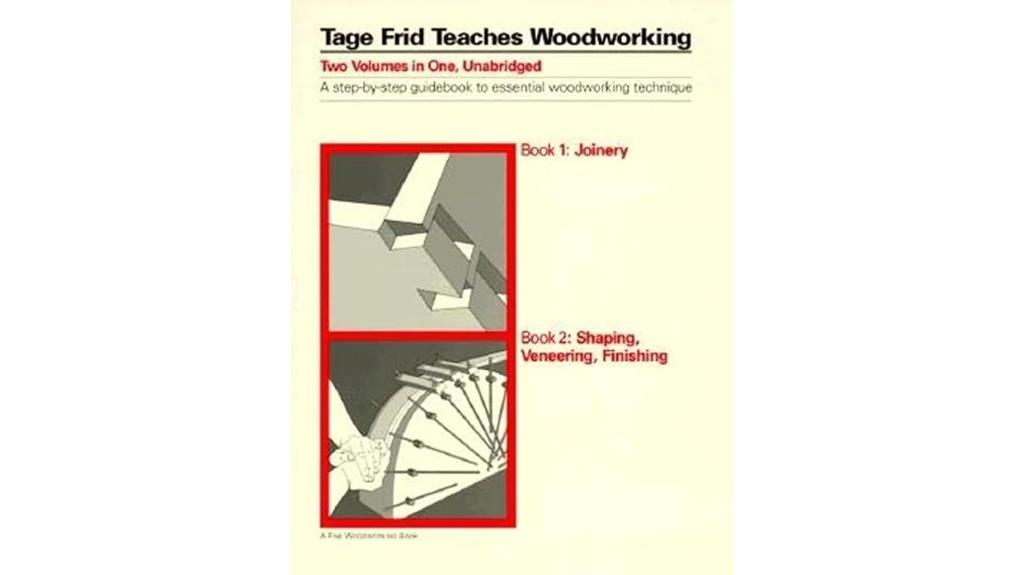
If you’re enthusiastic to master advanced woodworking techniques, “Tage Frid Teaches Woodworking, Book 2: Shaping, Veneering, Finishing” offers detailed guidance on veneering that’s perfect for both dedicated hobbyists and seasoned craftsmen. This second book in the series covers shaping, veneering, and finishing, with clear, well-illustrated methods. It emphasizes making and using joints like tongue and groove, spline miters, and dovetails. Recommended by expert woodworkers, it’s a practical resource that encourages applying techniques to real projects. Despite pandemic delays, the book arrived quickly and is highly valued for its exhaustive advice from a master, making it a must-have for serious woodworkers.
Best For: dedicated hobbyists and experienced woodworkers seeking comprehensive guidance on shaping, veneering, and finishing techniques to enhance their craft.
Pros:
- Well-illustrated, detailed instructions suitable for all skill levels
- Covers both basic and advanced woodworking joints and techniques
- Highly recommended by expert woodworkers and praised for practical advice
Cons:
- Black and white illustrations may lack the visual clarity of color images
- As part of a series, it might be best complemented by volumes 1 and 3 for full context
- Some readers might find the content dense if they prefer quick, simplified guides
Red Oak Veneer Sheets for Woodworking and Crafts
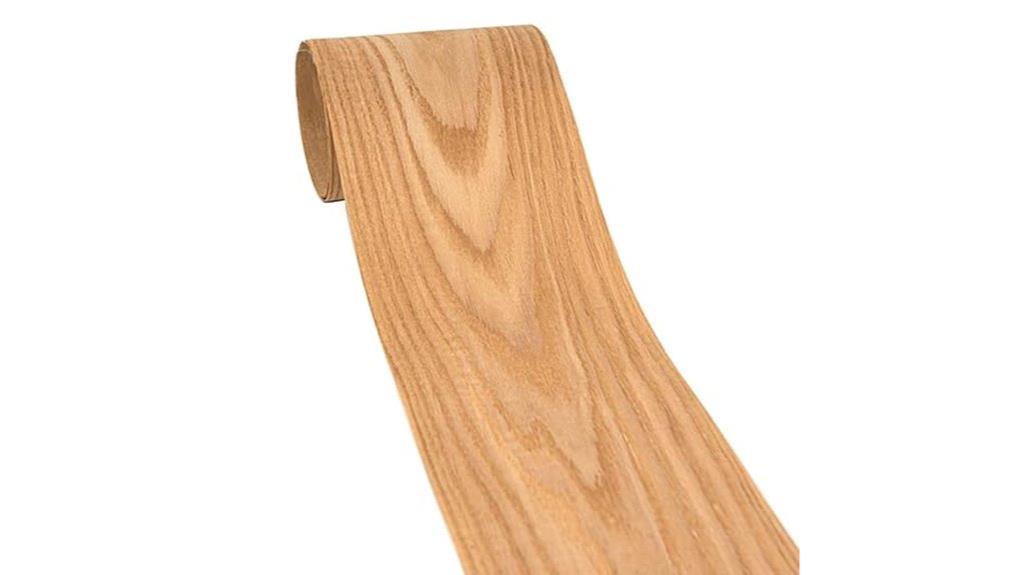
Red Oak Veneer Sheets stand out as an excellent choice for hobbyists and DIY enthusiasts seeking an affordable way to add authentic woodgrain to their projects. Made from genuine Red Oak, these veneers display striking patterns and natural beauty. They are flexible, durable, and easy to work with, thanks to a non-woven backing that improves stability during application. Measuring about 9 x 98 inches with a thickness of 0.25mm, they suit furniture, crafts, and decorative accents. While thin and delicate, proper handling and adhesive application can yield stunning results. Despite some challenges, these veneers provide a budget-friendly option for creative woodworking and decorative projects.
Best For: DIY enthusiasts, hobbyists, and budget-conscious woodworkers seeking authentic-looking red oak veneer for decorative and craft projects.
Pros:
- Natural Red Oak pattern with attractive woodgrain appearance
- Flexible and easy to handle with non-woven backing for stability
- Cost-effective alternative to thicker or premium veneer options
Cons:
- Extremely thin (0.25mm) can be difficult to work with and prone to splitting
- May produce uneven finishes or air bubbles during application
- Less durable and not suitable for heavy-duty or structural use
Walnut Wood Veneer Edge Banding (1-1/2 Inch x 50ft Roll)
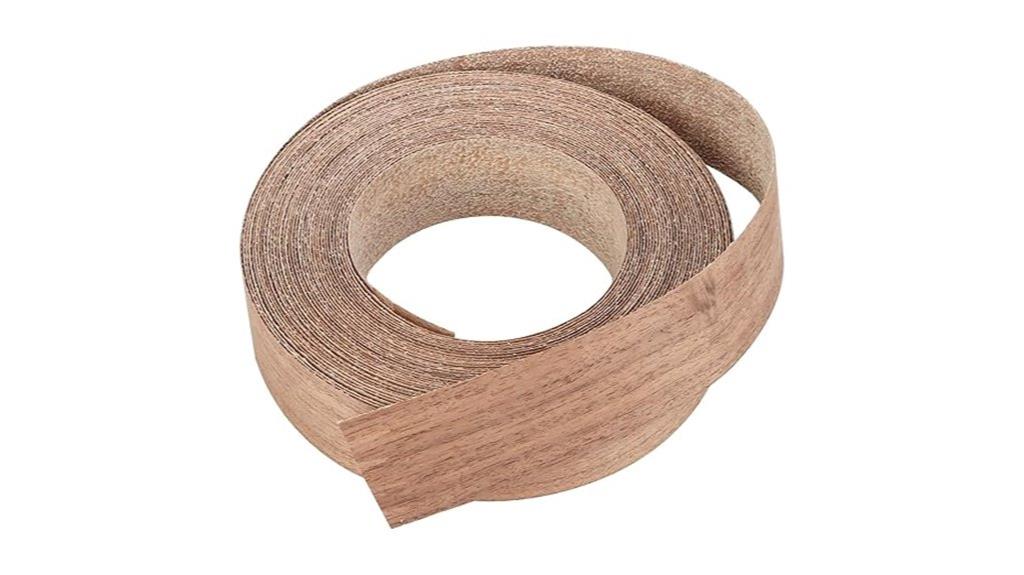
For anyone looking to achieve a professional, high-quality finish on their woodworking projects, the Walnut Wood Veneer Edge Banding (1-1/2 Inch x 50ft Roll) offers an excellent solution. Made from high-quality solid wood, it features a smooth surface resistant to dirt and provides excellent bonding. The beautiful walnut grain adds elegance while the thin 0.8 mm profile ensures a sleek, seamless look. Easy to apply with a heated iron and pre-glued backing, it’s perfect for sealing edges on furniture, cabinets, or shelves. The durable veneer safeguards against moisture and enhances aesthetic appeal, making it a practical choice for both DIYers and professionals.
Best For: DIY enthusiasts and professionals seeking a durable, attractive edge finishing solution for furniture, cabinets, and crafts.
Pros:
- High-quality solid wood veneer with a beautiful walnut grain for an elegant appearance
- Easy application using a heated iron and pre-glued backing for quick, secure bonding
- Durable and moisture-resistant, providing long-lasting protection and enhanced aesthetics
Cons:
- The sparse pre-glued adhesive can require careful handling during application
- The 50 ft roll size may be limiting for larger projects or extensive use
- Reheating is necessary for repositioning, which might be inconvenient for some users
Exotic Fingerboard Wood Veneer Pack 60 Pieces Makes 12 Boards Maple Pre Cut
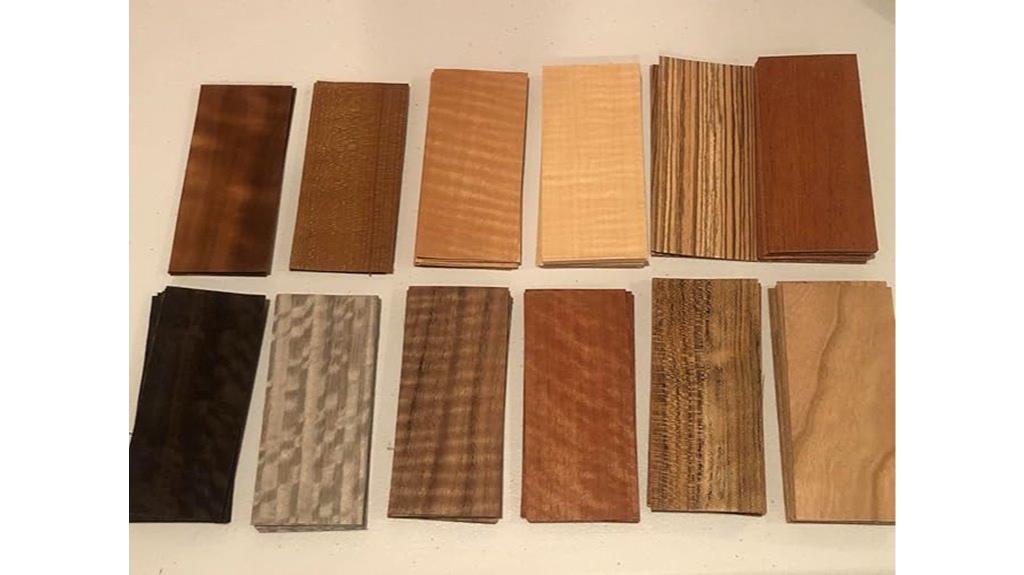
The Exotic Fingerboard Wood Veneer Pack is an excellent choice for hobbyists and craftsmen seeking high-quality materials to create unique, professional-looking fingerboards. It includes 60 thin veneer pieces, enough to make 12 complete boards, with a mix of maple core and exotic wood veneers like Zebrawood, Teak, and Walnut. The pieces measure 2” x 4.5”, offering versatility for straight and cross-cut designs. While some pieces may arrive with cracks or be softer, overall, the pack provides vibrant, premium materials perfect for creative projects. It’s a great way to explore different wood types and craft eye-catching fingerboards with a premium finish.
Best For: hobbyists, crafters, and fingerboard enthusiasts seeking high-quality, exotic wood veneer materials for custom fingerboard projects.
Pros:
- Contains a diverse variety of exotic woods and maple veneers, offering creative flexibility.
- High-quality, vibrant veneers that produce professional-looking fingerboards.
- Includes both straight and cross-cut options for unique design possibilities.
Cons:
- Some veneer pieces may arrive with cracks or be softer than others.
- Price is slightly high relative to the small amount of material provided.
- Veneer pieces are very thin and may be considered flimsy or delicate for certain applications.
Veneering, Marquetry and Inlay (Best of Fine Woodworking)
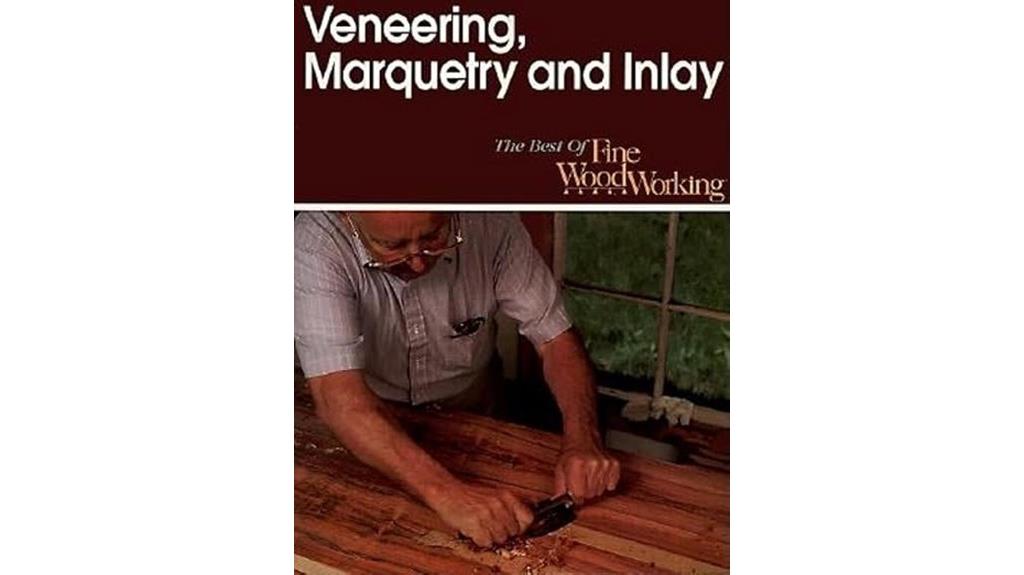
If you’re enthusiastic to master fine woodworking techniques that combine artistry and craftsmanship, “Veneering, Marquetry, and Inlay” from Best of Fine Woodworking stands out as an essential resource. It offers clear guidance, detailed instructions, and high-quality illustrations to help you develop your skills. The collection of 23 articles covers fundamentals, traditional, and modern methods, inspiring you to create beautiful, intricate designs. While building expertise takes time and patience, the book emphasizes setting up a well-equipped workspace with key tools. Whether making decorative boxes or inlaid furniture, this resource encourages experimentation with various woods and materials for stunning results.
Best For: woodworking enthusiasts seeking comprehensive guidance and detailed techniques in veneering, marquetry, and inlay to enhance their craftsmanship and create beautiful, intricate projects.
Pros:
- Offers detailed instructions with high-quality illustrations, making complex techniques accessible.
- Covers a wide range of methods, including traditional and modern approaches, suitable for various skill levels.
- Emphasizes practical advice on workspace setup and tool selection to ensure successful project completion.
Cons:
- Lacks extensive, specific detail on inlay techniques, which may require supplementary resources.
- Mastery of techniques requires significant time, patience, and practice for best results.
- Assumes some basic workshop equipment, such as circular saws and jigsaws, which may necessitate additional investment for beginners.
Docynia Delavayi Burl Veneer Sheet (17×19 Inches)
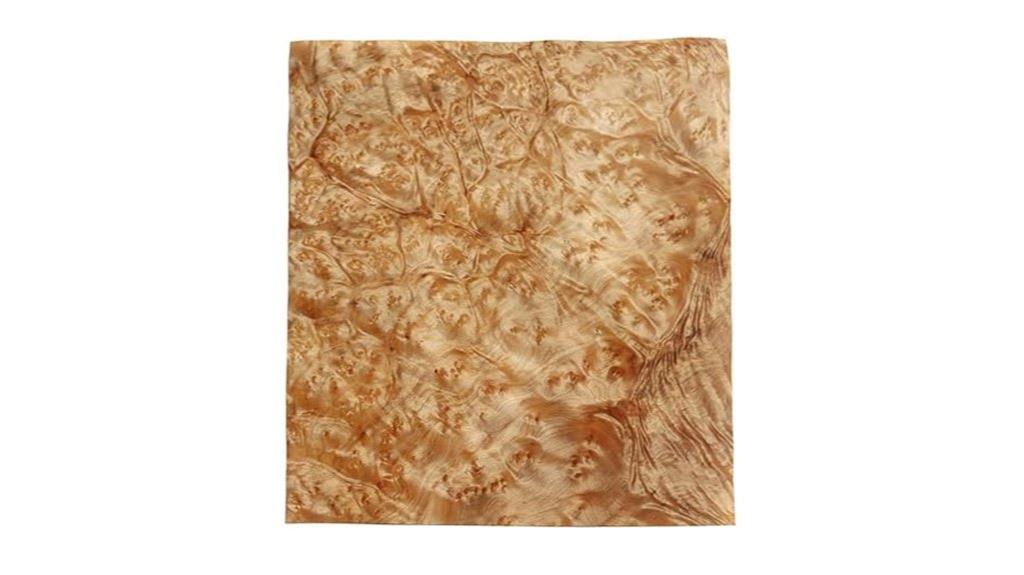
A great choice for intricate woodworking and craft projects, the Docynia Delavayi Burl Veneer Sheet stands out with its distinctive burl patterns and natural imperfections. Measuring approximately 17×19 inches, each sheet offers unique knots, burl eyes, and character that add authenticity and elegance. Its thin profile of 0.25 mm makes it ideal for detailed inlay work, while the backing of non-woven fabric guarantees stability during application. Though delicate and limited in color absorption, it’s perfect for decorative surfaces and fine veneers. With proper handling—like pressing and careful cutting—it delivers stunning, one-of-a-kind finishes that elevate any project.
Best For: artisans and craftspeople seeking detailed, natural wood veneer for fine woodworking, inlay, and decorative projects requiring unique burl patterns.
Pros:
- Unique burl patterns and natural imperfections add authenticity and visual interest.
- Thin profile (0.25 mm) ideal for detailed inlay and intricate work.
- Backing of non-woven fabric provides stability and ease of application.
Cons:
- Very delicate, which can make handling and cutting challenging.
- Limited ability to absorb color, restricting certain decorative effects.
- Small size (17×19 inches) may require multiple sheets for larger projects.
Factors to Consider When Choosing Wood Veneering
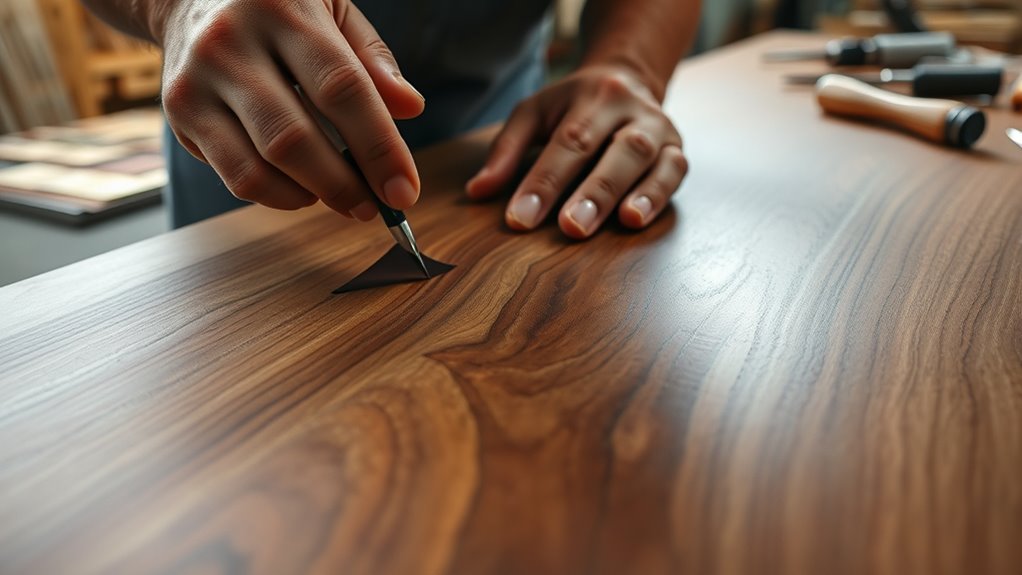
When selecting the right wood veneer, I consider several key factors to guarantee the best fit for my project. I look at veneer thickness options, the specific wood species, and the application techniques required. Balancing my budget with quality and understanding project compatibility helps me make informed choices.
Veneer Thickness Options
Have you ever wondered how the thickness of veneer impacts your woodworking project? Veneer thickness varies from ultra-thin (around 0.2mm) to thicker options (up to 1.0mm), influencing flexibility and strength. Thinner veneers, about 0.2mm to 0.4mm, are perfect for intricate inlay work and curved surfaces because they bend easily. Thicker veneers, between 0.6mm and 1.0mm, offer more durability and are better suited for structural parts or surfaces that need less finishing. Handling also depends on thickness—thin sheets are more delicate and prone to splitting. When choosing, consider your project’s needs—whether you require flexibility, strength, or ease of handling—and match the veneer thickness accordingly for the best results.
Wood Species Selection
Choosing the right wood species for veneering depends on several key factors that influence both the appearance and performance of your project. Different woods offer distinct colors, grain patterns, and textures, shaping the overall look. Hardwoods like walnut, maple, and cherry provide durability and fine grain, ideal for long-lasting pieces. Softer woods such as pine are easier to work with but less resistant to wear. Exotic woods like zebrawood or bubinga deliver striking visuals but can be costly and may require special handling. It’s also important to contemplate the wood’s stability and how it reacts to humidity, ensuring it suits your environment. Matching porosity and color among species helps achieve a uniform, cohesive finish, making your veneering project look seamless.
Application Techniques Needed
Selecting the right application techniques for wood veneering is essential to achieving a flawless finish and long-lasting results. I consider the veneer type and project complexity when choosing methods like pressing, gluing, or steaming. Proper surface prep, including cleaning and sealing, ensures better adhesion and reduces veneer failure risks. Techniques such as vacuum bagging, clamping, or using cauls help keep the veneer flat and smooth, preventing air pockets or wrinkles. I also select the appropriate adhesive—whether contact cement, hide glue, or PVA—based on veneer thickness, substrate, and desired durability. Finally, mastering finishing methods like sanding, polishing, or sealing enhances the appearance and protects the veneer, contributing to a stunning, professional result that lasts over time.
Project Compatibility Factors
When planning a wood veneering project, verifying that the veneer suits the specific application can make all the difference in achieving a professional result. First, check that the veneer thickness aligns with your needs—0.4mm is ideal for delicate surfaces, while 1.5mm offers more structural strength. Next, ensure the species and grain direction match your aesthetic goals, whether you want symmetrical bookmatching or curved surfaces with radial cuts. Confirm that the size and shape of the veneer fit your project dimensions and pattern matching requirements. Also, evaluate the backing material—paper, fabric, or none—and its compatibility with your adhesive and pressing method. Finally, consider the surface material’s properties to verify the veneer’s flexibility, stability, and color will produce the desired finish.
Budget and Quality Balance
Balancing your budget with the desired quality is essential in wood veneering projects, as it helps guarantee you get the best results without overspending. Choosing the right veneer involves trade-offs between price and appearance or durability. Thinner veneers, like 0.25mm, are more affordable but can be delicate and harder to work with, potentially impacting the final look. Higher-grade veneers with consistent grain, rich color, and minimal defects cost more but deliver superior aesthetics and longevity. Budget-friendly options, such as dyed or paper-thin veneers, may need careful handling and extra finishing to achieve a professional appearance similar to thicker, higher-quality veneers. Ultimately, evaluating your project’s purpose—decorative or structural—guides you toward the best balance between cost and quality.
Frequently Asked Questions
How Do I Select the Best Veneer for Different Project Types?
Choosing the right veneer depends on your project’s purpose and desired look. I consider the wood species, grain pattern, and thickness to match durability and aesthetic needs. For furniture, I prefer thicker, stable veneers, while thinner ones suit intricate inlays. I also think about color consistency and budget. By evaluating these factors, I ensure I select the best veneer that enhances my project’s beauty and longevity.
What Are Common Mistakes to Avoid in Veneering?
When veneering, I’ve learned to avoid common mistakes like rushing the glue-up process or not properly preparing the surface. I also steer clear of using too much glue, which can cause bleed-through, and I always make certain the veneer is correctly aligned before pressing. Additionally, I avoid applying excessive pressure, as it can warp the veneer. Paying attention to these details helps me achieve smooth, professional-looking finishes every time.
How Long Does a Typical Veneering Project Take?
Oh, a typical veneering project? Well, it’s never as quick as you’d hope. Honestly, it can take anywhere from a weekend to several days, depending on the complexity and your experience. I’ve learned to expect a bit of patience—think of it as a mini marathon, not a sprint. If you’re meticulous and avoid rushing, you’ll end up with a stunning finish that’s worth every minute.
Can Veneer Be Applied on Curved Surfaces?
Absolutely, veneer can be applied on curved surfaces. I’ve done it myself and found that flexible veneers or using contact cement helps it conform smoothly. I carefully cut the veneer to match the curves, then gently press it into place, ensuring it adheres well without bubbles or wrinkles. With patience and the right tools, achieving a flawless finish on curved surfaces is definitely possible and looks stunning.
What Maintenance Is Required for Veneered Finishes?
I get why you’re curious about maintaining veneered finishes. It’s actually quite manageable! I recommend regular dusting and gentle cleaning with a soft cloth. Avoid harsh chemicals and excessive moisture, which can damage the veneer. If you notice scratches or wear, light touch-ups with matching finish can revive the look. With a little care, your veneered surfaces will stay stunning and durable for years to come.
Conclusion
If you’re like most woodworkers, you’ll be amazed to learn that veneering can elevate your projects—over 70% of high-end furniture features veneered surfaces. Whether you’re exploring classic techniques or trying innovative methods, the right veneer can transform your work. With so many options and skills to master, I encourage you to experiment and discover what truly inspires you. Veneering isn’t just a craft; it’s a pathway to stunning, professional finishes that stand the test of time.
